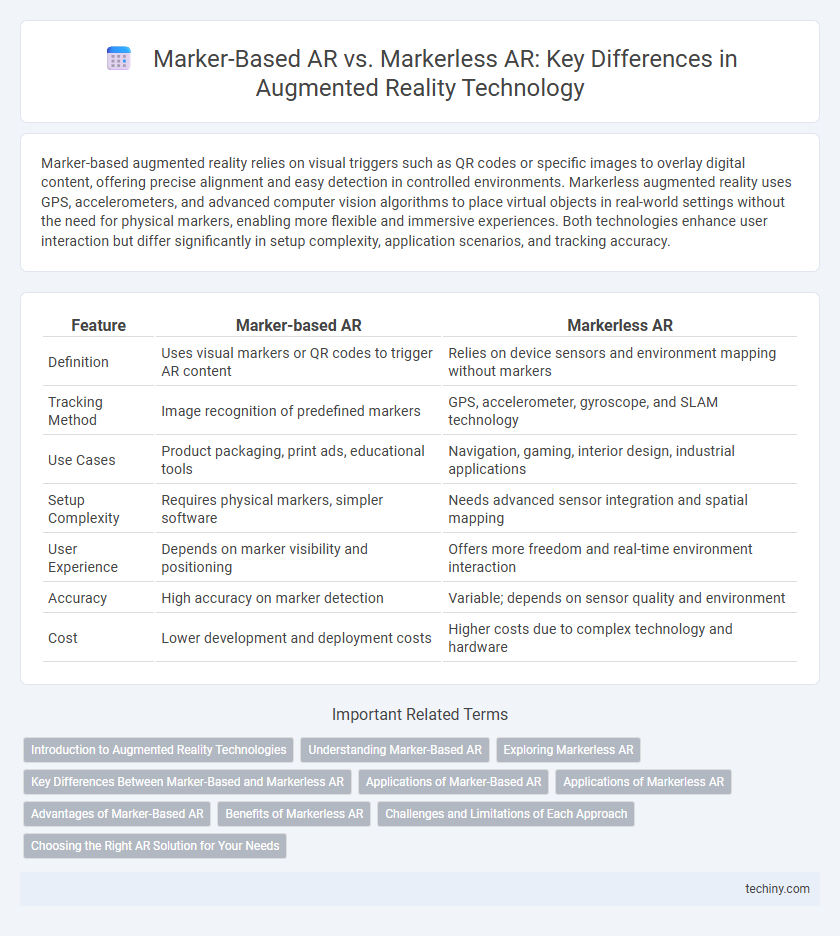Marker-based augmented reality relies on visual triggers such as QR codes or specific images to overlay digital content, offering precise alignment and easy detection in controlled environments. Markerless augmented reality uses GPS, accelerometers, and advanced computer vision algorithms to place virtual objects in real-world settings without the need for physical markers, enabling more flexible and immersive experiences. Both technologies enhance user interaction but differ significantly in setup complexity, application scenarios, and tracking accuracy.
Table of Comparison
| Feature | Marker-based AR | Markerless AR |
|---|---|---|
| Definition | Uses visual markers or QR codes to trigger AR content | Relies on device sensors and environment mapping without markers |
| Tracking Method | Image recognition of predefined markers | GPS, accelerometer, gyroscope, and SLAM technology |
| Use Cases | Product packaging, print ads, educational tools | Navigation, gaming, interior design, industrial applications |
| Setup Complexity | Requires physical markers, simpler software | Needs advanced sensor integration and spatial mapping |
| User Experience | Depends on marker visibility and positioning | Offers more freedom and real-time environment interaction |
| Accuracy | High accuracy on marker detection | Variable; depends on sensor quality and environment |
| Cost | Lower development and deployment costs | Higher costs due to complex technology and hardware |
Introduction to Augmented Reality Technologies
Marker-based AR uses predefined visual markers, such as QR codes or images, to anchor digital content in the real world, enabling precise tracking and interaction. Markerless AR relies on sensors and GPS data to detect surfaces and environments, offering greater flexibility for applications like navigation and gaming without the need for physical markers. Both technologies leverage computer vision and sensor fusion to blend virtual objects seamlessly with real-world scenes, driving innovation in augmented reality experiences.
Understanding Marker-Based AR
Marker-based AR relies on specific visual markers, such as QR codes or predefined images, to trigger and align digital content within the real-world environment. This technology uses computer vision algorithms to detect and track these markers, enabling precise overlay of virtual objects. Marker-based AR is ideal for applications needing high accuracy and consistent positioning, such as interactive product displays and educational tools.
Exploring Markerless AR
Markerless AR leverages advanced computer vision algorithms and GPS data to overlay digital content without relying on physical markers, enabling seamless augmentation in diverse environments. This technology enhances user experience by supporting real-time interaction with virtual objects in open spaces, making it ideal for applications in navigation, gaming, and retail. The flexibility of markerless AR contributes to its growing adoption across industries, as it allows for dynamic, context-aware content delivery on mobile devices and AR glasses.
Key Differences Between Marker-Based and Markerless AR
Marker-based AR relies on distinct visual markers or patterns to trigger digital content, ensuring precise alignment and tracking but limiting use to marker visibility and environmental conditions. Markerless AR uses advanced sensors and GPS data to overlay information without the need for physical markers, enabling greater flexibility and scalability across diverse applications such as gaming, navigation, and retail. The key differences lie in tracking methods, environmental dependence, and versatility, with marker-based AR providing accuracy in controlled scenarios while markerless AR offers seamless integration into real-world environments.
Applications of Marker-Based AR
Marker-based AR is widely used in educational tools, enhancing learning by overlaying interactive 3D models on textbooks and printed materials. It is also prevalent in marketing, enabling consumers to visualize products through branded markers on packaging or advertisements. Furthermore, industries like manufacturing and maintenance benefit from marker-based AR by providing workers with precise guidance and real-time information when scanning predefined markers on equipment.
Applications of Markerless AR
Markerless AR leverages GPS, accelerometer, and gyroscope data to overlay digital content without relying on predefined markers, enabling seamless integration with the environment. It is widely applied in navigation systems, allowing real-time directional cues and points of interest for pedestrians and drivers. Industries such as retail benefit from markerless AR by providing virtual try-ons and interactive product visualizations that enhance customer engagement and personalization.
Advantages of Marker-Based AR
Marker-based AR offers precise object recognition and tracking through predefined visual markers, ensuring accurate superimposition of digital content in real-world environments. This technology requires minimal processing power compared to markerless AR, resulting in faster performance and lower latency. Its reliability in controlled settings makes it ideal for applications in education, marketing, and industrial training where exact alignment is critical.
Benefits of Markerless AR
Markerless AR offers enhanced flexibility by eliminating the need for predefined visual markers, allowing users to interact seamlessly with their real-world environment. It enables dynamic content placement and real-time environment mapping through advanced GPS, accelerometer, and camera data integration. This technology supports broader applications in navigation, gaming, and retail by providing intuitive, location-based, and context-aware augmented experiences.
Challenges and Limitations of Each Approach
Marker-based AR relies on predefined visual markers for accurate tracking, but it faces challenges with marker occlusion, lighting conditions, and limited user mobility. Markerless AR offers greater flexibility by using environmental features for tracking, yet it struggles with inconsistent surface detection, high computational demands, and reduced accuracy in complex or dynamic environments. Both approaches encounter limitations related to device performance and real-time processing, impacting seamless user experiences.
Choosing the Right AR Solution for Your Needs
Marker-based AR relies on visual markers like QR codes to trigger digital content, making it ideal for controlled environments and detailed object recognition. Markerless AR uses GPS, accelerometers, and SLAM technology to overlay information without physical markers, offering greater flexibility for outdoor and large-scale applications. Selecting the right AR solution depends on factors such as the deployment environment, user interaction requirements, and the level of precision needed for object tracking.
Marker-based AR vs Markerless AR Infographic

 techiny.com
techiny.com